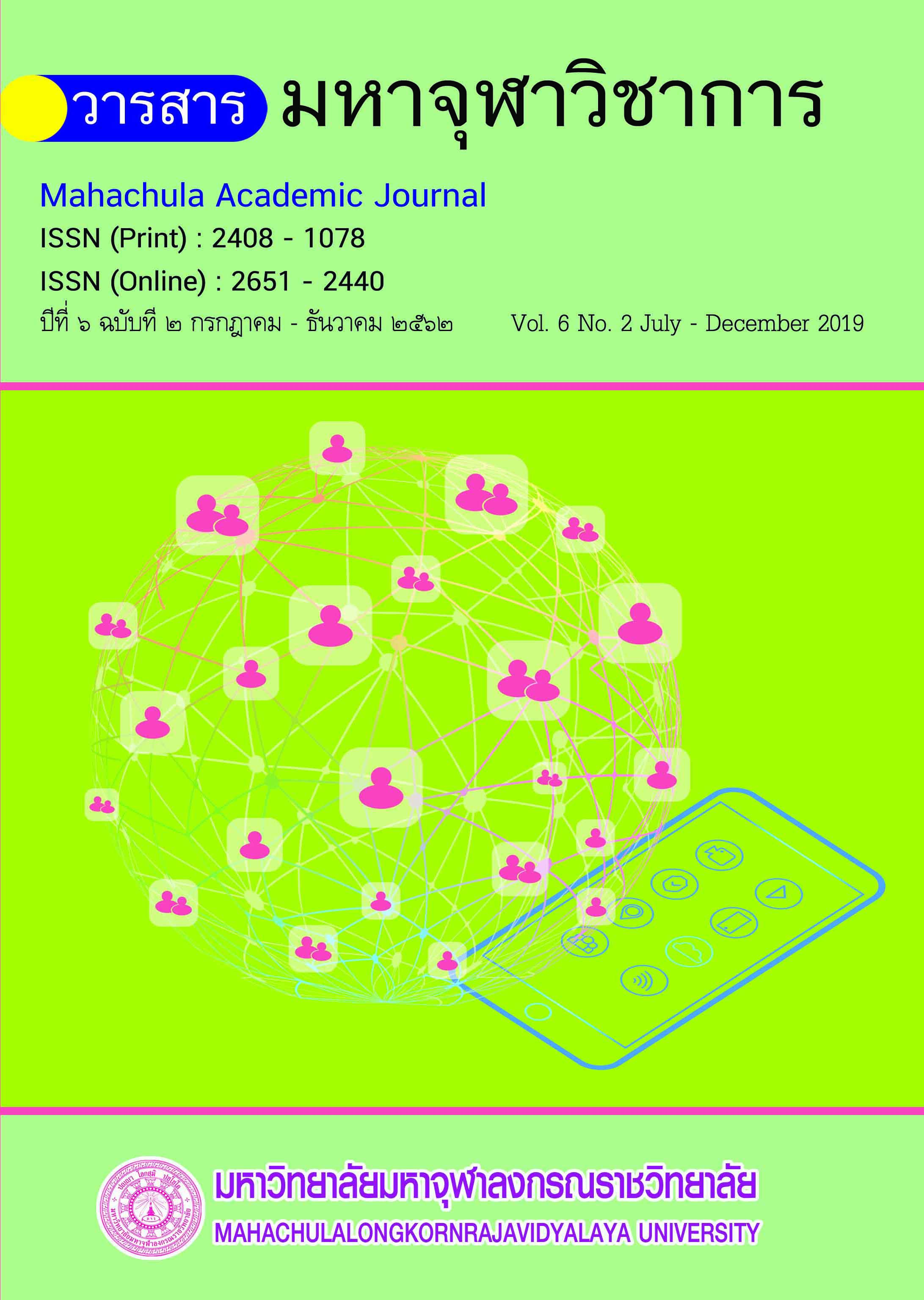การอยู่ร่วมกันของคนในสังคมพหุวัฒนธรรมในประเทศไทย กรณีศึกษาสังคมพหุวัฒนธรรมในอำเภอเมือง จังหวัดเชียงใหม่
Main Article Content
บทคัดย่อ
การวิจัยมีวัตถุประสงค์ (๑) เพื่อศึกษาวิเคราะห์หลักการอยู่ร่วมกันของคนในสังคมพหุวัฒนธรรมในชุมชนประตูท่าแพ อำเภอเมือง จังหวัดเชียงใหม่ (๒) เพื่อวิเคราะห์ความสอดคล้องของหลักการอยู่ร่วมกันของคนในสังคมพหุวัฒนธรรม ตามหลักการของแต่ละศาสนา (๓) เพื่อนำเสนอรูปแบบและวิธีการอยู่ร่วมกันของคนในสังคมพหุวัฒนธรรมที่เหมาะสมสำหรับสังคมไทยอย่างเป็นรูปธรรม การวิจัยเชิงคุณภาพ ผู้วิจัยได้ศึกษาจากเอกสาร การสัมภาษณ์เชิงลึก จากผู้ทรงคุณวุฒิ ให้ข้อมูลสำคัญ จานวน ๙ รูป/คน โดยการวิเคราะห์ข้อมูลแบบอรรถาธิบายและพรรณนาความ
ผลการวิจัยพบว่า ๑. หลักการอยู่ร่วมกันของคนในสังคมพหุวัฒนธรรมในชุมชนประตูท่าแพ อำเภอเมือง จังหวัดเชียงใหม่ ด้วยการสร้างให้ประชาชนในชุมชนประตูท่าแพเข้าใจ และยอมรับซึ่งความแตกต่างในเรื่องของแนวคิดวัฒนธรรมประเพณี และความแตกต่างทางด้านเชื้อชาติ ภาษา ศาสนา ลัทธิความเชื่อ ๒. ความสอดคล้องของหลักการอยู่ร่วมกันของคนในสังคมพหุวัฒนธรรม ตามหลักการของแต่ละศาสนา คือ การอยู่ร่วมกันของชุมชนชาวพุทธ คือ การรักษาศีล ๕ พูดจาที่ไพเราะไม่สร้างความแตกแยกให้เกิดในชุมชน ทำตนให้เป็นประโยชน์ ชุมชนชาวคริสต์ ส่งเสริมให้มีการพัฒนาเปิดกว้างแต่ละชุมชนสู่สังคมอย่างเท่าเทียมกัน ให้ทุกคนในสังคมหันมาเข้าใจความแตกต่าง และสนใจเรียนรู้ความแตกต่างกับความรู้ที่มีอยู่ ๓. การอยู่ร่วมกันของคนในสังคมพหุวัฒนธรรมในประเทศไทย : กรณีศึกษาสังคมพหุวัฒนธรรมในอำเภอเมือง จังหวัดเชียงใหม่ เพื่อนำเสนอรูปแบบและวิธีการอยู่ร่วมกันของคนในสังคมพหุวัฒนธรรมที่เหมาะสมสำหรับสังคมไทยอย่างเป็นรูปธรรม คือ ในชุมชนชาวพุทธ ส่งเสริมเยาวชนและประชาชนที่อยู่รอบวัด ชุมชนชาวคริสต์ คือ ส่งเสริมการยอมรับในเรื่องความแตกต่างในเรื่องความคิดตลอดจนมีทัศนคติที่ดีในการอยู่ร่วมกัน อันจะเป็นผลให้การอยู่ร่วมกันในชุมชนที่มีความหลากหลายอย่างมีประสิทธิภาพ
Article Details
เอกสารอ้างอิง
ธัญญวรินทร์ ภักดีธนกิตต์. "การศึกษาเปรียบเทียบการพัฒนาความประพฤติของมนุษย์ในพระพุทธศาสนาเถรวาทกับศาสนาคริสต์นิกายโรมันคาทอลิก”. วิทยานิพนธ์พุทธศาสตรมหาบัณฑิต สาขาวิชาศาสนาเปรียบเทียบ. บัณฑิตวิทยาลัย: มหาวิทยาลัย มหาจุฬาลงกรณราชวิทยาลัย, ๒๕๕๗.
รัชนีกร เศรษฐโฐ. สังคมและวัฒนธรรมไทย. กรุงเทพมหานคร: สำนักพิมพ์ไทยวัฒนาพานิช, ๒๕๕๔.
สุพัตรา สุภาพ. สังคมวิทยา. กรุงเทพมหานคร: โรงพิมพ์ไทยวัฒนาพานิช, ๒๕๕๓.
ประเสริฐ แย้มกลิ่นฟุ้ง. สังคมและวัฒนธรรม. กรุงเทพมหานคร: สำนักพิมพ์แห่งจุฬาลงกรณ์มหาวิทยาลัย, ๒๕๕๓.
พินิจ ลาภธนานนท์. "การผสมผสานวิถีปฏิบัติและประเพณีทางพุทธศาสนาในพื้นที่ชายแดนไทย-เมียนมา : การส่งเสริมประชาคมสังคมและวัฒนธรรมอาเซียนในบริบทสังคมพหุวัฒนธรรม". วารสาร มจร สังคมศาสตร์ปริทรรศน์. ปีที่ ๖ ฉบับที่ ๒ (ฉบับพิเศษ) เมษายน-มิถุนายน ๒๕๖๐.
อานันท์ กาญจนพันธ์. "พหุวัฒนธรรมในบริบทของการเปลี่ยนผ่านทางสังคมและวัฒนธรรม". รายงานการวิจัย. ศูนย์ภูมิภาคทางสังคมศาสตร์และการพัฒนาอย่างยั่งยืน. คณะสังคมศาสตร์ : มหาวิทยาลัยเชียงใหม่, ๒๕๕๑.
อมาวสี อัมพันศิริรัตน์. "การดูแลอย่างเอื้ออาทรของนักศึกษาพยาบาลต่างวัฒนธรรม : มุมมองของพุทธและมุสลิม". เอกสารวิจัยส่วนบุคคลวิทยาลัยพยาบาลบรมราชชนนีสงขลา, ๒๕๕๐.
พระครูปลัดปรีดา ใจบุญ. สัมภาษณ์. เจ้าอาวาสวัดดอกเอื้อง ตำบลศรีภูมิ จังหวัดเชียงใหม่ ๒๓ กรกฎาคม, ๒๕๖๐.
พ.ต.ท. สุวิทย์ ปัญโญ. สัมภาษณ์. ผู้กำกับการสืบสวนสอบสวนสถานีตำรวจภูธรเมืองเชียงใหม่ ๒๓ กรกฎาคม, ๒๕๖๐.
ศจ.ไมตรี อนันตนิติเวทย์. สัมภาษณ์. กรรมการโบสถ์คริสต์โปรแตสแต๊นท์ จังหวัดเชียงใหม่ ๒๓ กรกฎาคม, ๒๕๖๐.
จินดารัตน์ โพธิ์นอก. “พหุวัฒนธรรม”. [ออนไลน์]. แหล่งที่มา : https://www.dailynews.co.th/article/236022 [๗ เมษายน ๒๕๖๑].


